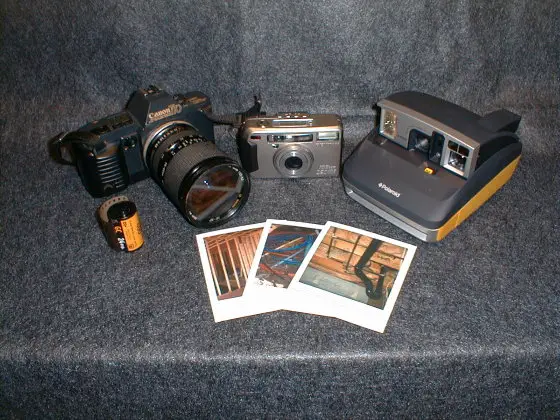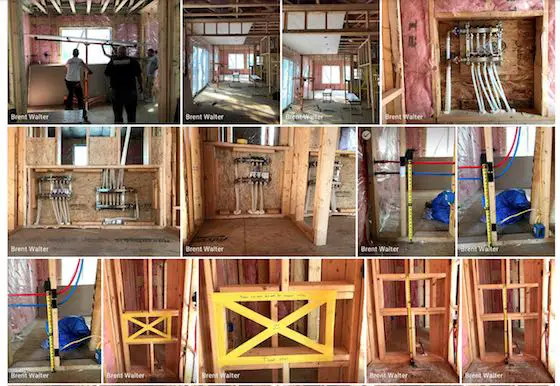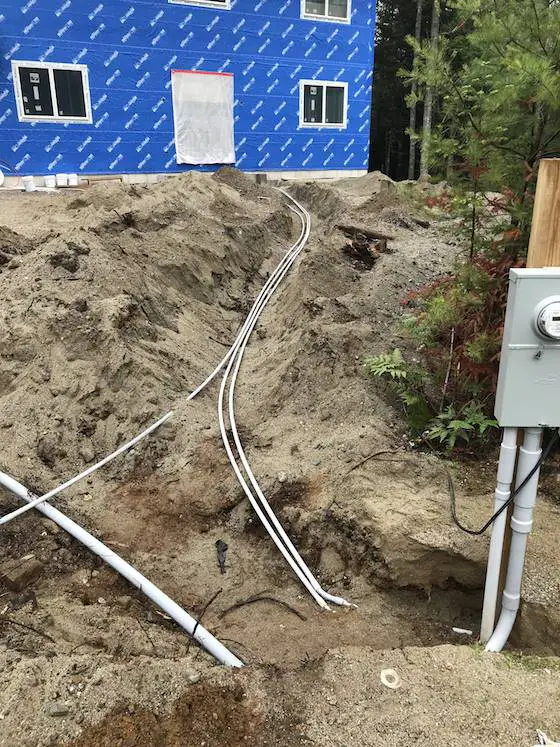Home Building Photos – Take Thousands of Them

Home Building Photos | This photo above shows you how important photos can be to CAPTURE the past! Modern digital cameras with instant preview screens ELIMINATE the need for two of the cameras above. And FILM? Are you kidding me? This photo was taken in September of 2003 before smartphones even existed.
Home Building Photos - You Can't Take Too Many
DEAR TIM: We plan to build a new home soon and wonder about how best to document the progress of the job. Taking photographs seems so straightforward but I wonder if they will be enough? Are some photographs better than others? Is digital photography acceptable? What cameras would you use? What are the key photographs you would take if you were me? Kristin P., Somerville, MA
DEAR KRISTIN: I can't begin to tell you how many times a photograph has saved me enormous amounts of time and money. I took many photographs as I built my home 18-years-ago and they come in handy from time to time as I do small remodeling projects around the house.
Just last summer the photos helped the crew that installed a buried radio fence wire that created an invisible fence for my new dog. The photos saved these men at least 30 minutes of exploratory digging, as they quickly located a nearby buried gas line and a downspout line.
Should I Shot Remodeling Photos?
You don't have to be building a new home to benefit from photography. Photos taken during remodeling jobs, and even during routine replacement of mechanical systems can be worth their weight in gold at a later date.
Homeowners can also use cameras to capture images of things that can't readily seen such as rotted roof sheathing, cracked and crumbling chimney crowns, and any surface that will be hidden by a building material such as concrete, drywall, exterior siding, brick, etc. These photos take the place of x-ray vision that seems to be available only if you happen to be a superhero.

Upload your home-building photos and videos to the cloud for SAFE long-term storage. These are just a few of about 10,000 photos shot of my daughter's new home being built.
Can Photos Win a Lawsuit?
Not only are some photographs more valuable than others, but the actual method of photography can also be more valuable. Let's assume for a moment you and your builder get involved in a dispute in the future that gets dragged into the justice system. Photographs that were taken with a camera that uses traditional film or with cameras that produce instant photographs on real prints can't be altered.
Anyone who purchases an off-the-shelf software program and learns a few tricks can alter digital photographs to such an extent that the image doesn't really match what was shot by the camera. For purposes of evidence, traditional negatives or instant photographic prints are the best.
What Cameras Do Best?
I have three cameras that I prefer to use. They all take excellent photographs, but each camera has its strengths and weaknesses. My 19-year-old single-lens reflex 35 mm camera still works as well as the day it took its first photograph. I have an assortment of lenses and accessories that allow me to take just about any photo I need. Its powerful telephoto lens allows me to take distant photos as if I am standing right in front of the subject.
I own a popular instant camera that spits out the actual photograph within a second of shooting the image. This camera is invaluable if you need to know immediately that you got a great photo, not just any photo.
Digital cameras, of course, offer the same advantage, but you need to do several other steps with your computer and printer to actually produce real photos. A cool printer that does not require a computer simply uses the camera's digital media storage card to transforms the data into actual photographic prints. It can make an actual print in this fashion every 90 seconds. Video cameras capture moving images and allow you to describe with your voice the things you are taping.
I feel the most important photos and video clips are the ones you can't get once the house is built. Anyone can take a photo of a door trim miter joint that is sloppy. But you only have a limited amount of time to take photos of things that will be covered up. I would love to see you take countless photos of the different aspects of the work such as the application of the outer skin is applied to your house, be it brick, stone, stucco, siding, etc.
Take Photos of Utility Trenches
Furthermore, taking photos of open utility trenches showing the placement of pipes and wires may be very important. Photographs of plumbing pipes in interior walls might be priceless down the road.

There's no doubt about where the conduit pipes are! You can orient off the electric meter and the front door.
All structural components such as bearing walls, column to beam connections, truss connections to all walls, seismic connectors, nailing patterns of structural plywood or OSB at outside corners, etc. are just a few photos you would find in my job site album.
You may have to make numerous trips at different times of day to get the photos, but figure out a way to make it happen. If you have to hire a neighbor or a retired friend who can visit the job frequently, then do so.
A common mistake most people make when taking construction photographs is they are too far away from the subject. If you are taking a photo of a distinct item such as a flashing detail behind brick, be sure the camera is no more than 30 inches away from the subject, not five or ten feet. Distant photographs may not provide the needed detail an expert needs to see at a later date.
Take photos of things you think are not important. An expert may see lots of things you would never think to look at or study. It is better to have hundreds of extra photos instead of missing the critical photo that was never taken. The $300 - 500 you spend on film and processing will be the best money you have ever spent.
Column 518